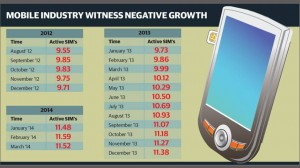The last time the number of subscribers saw a drop was in December 2012 after the regulators introduced post-registration activation
Following 15 consecutive months of growth, the country’s mobile phone operator industry has experienced a 0.56% decline in the number of subscribers in March, as one of the major operators saw a massive dip in its active users, although five of its competitors performed well.
Robi, the second largest operator in terms of revenue, lost 16.75 lakh (6.54%) of its active subscribers in March, claimed a report published by the country’s telecom regulators on Thursday.
The report by the Bangladesh Telecommunication Regulatory Commission (BTRC) shows that at the end of March, Robi’s active subscribers came down from the previous month’s 2.56 crore to 2.39 crore; while the other five operators managed to add a total of 10.69 lakh new active users during the same period.
The last time the number of subscribers saw a drop was in December 2012 after the regulators introduced post-registration activation.
Robi, however, said the number of its subscribers had reduced in March as they had changed the calculation process for declaring a SIM (subscriber identity module) active.
“It is just a number which will not impact Robi or the industry as a whole,” Mahmudur Rahman, executive vice-president of Robi, told the Dhaka Tribune yesterday.
According to a guideline from the telecom watchdog, if any SIM is found to receive or send no calls or SMS in 90 days, it will be counted as inactive.
“This time we were strict on the guideline and that is why the number of our subscribers showed a decline,” Mahmudur Rahman said.
He added that there was no reason to be worried as Robi had already informed the regulator about the issue.
However, the huge fall in Robi’s active subscribers also meant that the overall number of active subscribers declined to 11.52 crore from 11.58 crore at the end of February.
Sources at the Association of Mobile Telecom Operators of Bangladesh, however, said although the country had around 11.5 crore active subscribers, the actual number of active users was around 7.5 crore, as some of the subscribers used multiple SIMs.
Saying the declining number might be considered as a disaster for the industry, BTRC Vice-Chairman Md Giashuddin Ahmed told the Dhaka Tribune yesterday that the regulator wanted to know what caused Robi to suffer such a decline.
“As a regulator, we also need to know the inside story, although we have received a clarification from Robi,” he added.
Sources inside Robi said this was not the biggest disaster of the operator in terms of subscribers.
BTRC statistics show that in November 2009, Robi (then known as AKTel) lost 21.2 lakh subscribers in a single month, which also caused the total market size to come down to 5.06 crore from the previous month’s 5.14 crore.
Meanwhile, the latest figures from the BTRC shows that at the end of the first quarter of 2014, market leader Grameenphone had 4.87 crore active subscribers, including 4.70 lakh new ones in March.
Banglalink, the second largest operator in the country in terms of subscribers, managed to add 3.15 lakh new subscribers to take its total number of active subscribers to 2.94 crore.
Airtel added 46,000 new subscribers to secure the fourth position with 84.08 lakh active subscribers at the end of March.
Teletalk, the only state-owned mobile operator, added 2.22 lakh new active subscribers in March to take its total number of subscribers to 34.34 lakh.
Citycell, the oldest operator in the subcontinent, also added 16,000 subscribers to have a total of 14.14 lakh active subscribers.
Although the total number of mobile subscribers declined in March, the number of mobile internet users increased.
At the end of February, the country had a total of 3.61 crore internet users, including 3.46 crore people accessing internet through their mobile phones; while at the end of March, the total number grew to 3.69 crore, including 3.53 crore mobile internet users.
Source: UNBConnect










